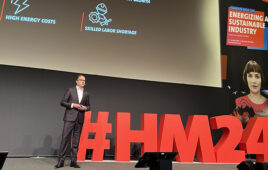By Cliff Ortmeyer, Global Head of Technical Marketing, Newark
Innovations such as AI, the IoT and the IIoT are pushing more intelligence out into harsh environments, resulting in industrial applications never thought possible before. But it’s also foreign territory for many electronic engineers who don’t have experience designing solutions for extreme conditions.
In factory automation and heavy industries such as oil and gas, vibration, temperature extremes, chemicals and fluids take their toll on electrical systems. Ruggedized applications require a different kind of component portfolio than traditional solutions. Standard connectivity approaches aren’t applicable in harsh environments where the stakes can be too high to fail. Design engineers must account for environmental factors before the design stage, choosing products with appropriate qualifications and ratings to ensure the protection of valuable equipment and personnel.
While we can’t explore the needs of the entire ecosystem of IIoT components here, focusing on a few key application building blocks will indicate which accommodations to make in a design.
Connectors
A good starting point is connectors since they are fundamental components to most IIoT applications. Whether they be HDMI, RJ45, RJ11, fiber optic, board-to-board connectors or other types, the key challenges are in preventing dust and liquid ingress, along with the ability to withstand rough handling.
Ruggedized connectors with IP67/1P68 or dynamic IP69k-rated environmentally-sealed connectors are a good choice for providing secure connections in harsh or hostile environments. They are particularly critical for underwater, agricultural, outdoor metering, medical equipment and other applications where frequent washing or exposure to moisture is an operational threat.
A robust locking/coupling mechanism is a must for harsh environment connectors as well. Types of connector couplings include ring, twist locking, threaded and quick disconnect couplings, all with different attributes for various types of applications.
Sensors
IoT applications use large arrays of sensors to collect data for transmission over the internet to a cloud-based computing resource. Sensing technologies such as accelerometers, encoders, temperature sensors, liquid level sensors, particle counters and humidity sensors must perform reliably in the most extreme situations to ensure both public safety and business continuity. The challenge for designers is that sensors must be small, resilient and low-power enough for ubiquitous deployment, while still being able to collect and deliver data in challenging environments, such as extreme heat, cold, blistering winds, high humidity or even chemicals.
As with connectors, seal integrity is essential for reliable operation of sensors in tough conditions. At minimum, they should meet IP standards. Also consider sensors made with corrosion-resistant materials, particularly for outdoor IoT applications. ISO has classified corrosivity categories for materials ranging from C1 (for very low corrosivity) to C5-I and C5-M (for very high industrial and marine applications, respectfully.
Switches
Electrical switches – such as snap action, toggle, tactile, and pushbutton switches – must also offer chemical resistance, ingress protection and other resistant properties for IIoT applications. Sealed switches are typically required to meet the challenges of extreme environments. Since switches are mechanical components that get a lot of human engagement, they tend to get banged around and exposed to a variety of fluids and contaminants from both human activity and the environment in which they operate. Think of medical applications, for example, where devices are constantly being moved around and can be exposed to blood and other fluids.
Switches need to handle the repeated impact of operators pressing or triggering too hard on the component. Another factor to consider is the materials the switches’ splash-proof boots are comprised of (such as silicon rubber or ethylene propylene rubber). Engineers should also consider requirements such as terminal type, actuator type, their IP rating, and whether the switches will require illumination, all of which would influence material selection.
Power
Unlike many larger connected systems, IoT products often do not have access to a main power source and must power themselves, typically using either energy harvesting or batteries. Energy harvesting is particularly promising for industrial applications because the energy required is taken from the environment, leveraging movement energy from the equipment, solar panels, heat, or other local sources of energy.
But energy harvesting isn’t suitable for all applications. Perhaps the power required for processing data on the device is too high, the needs of the communication technology are too demanding, or there simply isn’t a good source of energy to harvest. In these cases, batteries are often the largest part of an IoT sensor system, giving engineers a limited choice of which one to use. With a wide range of processors, communications technologies and software algorithms, however, the system can be designed to achieve the required lifetime. Often IoT sensors will be designed to operate for their entire life on the original battery, as the labor cost of replacement is so large.
Connectivity
In addition to harsh environmental factors such as temperature, moisture and humidity, IoT applications can be subjected to electrical interference from switching circuits, welding tools, and motors, amongst other things. If hardwired connectivity is the best choice, consider the effects of unwanted disconnection, either as a result of vibration or accidental force applied to the attached cable.
Standard connection technologies such as Ethernet and USB were designed for home or office environments, where frustration is the worst outcome of an unexpected disconnection. Industrialized connectors prevent such outcomes using locking mechanisms that increase the retention force of the industry standard connector, or by implementing ingress protection.
In addition to ruggedized USB or RJ45 Industrial Ethernet connectors, there are a range of standard industrial multi-pin connectors that transfer digital and analog signals along with power to the attached sensor.
When wireless connectivity makes sense, innovative antenna solutions will be required that are both optimal in their radio function and can withstand harsh environmental conditions. At their simplest, a single element antenna, possibly as a chip-antenna, is designed into a flexible printed circuit (FPC) as one approach. However, radio solutions that use multiple-input, multiple-output (MiMo) antennae are becoming an essential element of wireless connectivity.
Regardless of the approach taken, engineers need support and guidance when tackling the RF side of their applications. Custom antennae can often be the best approach, allowing the designer to take into consideration the materials used, the environment, and the object upon which the antenna is mounted.
Newark
www.newark.com
Filed Under: Factory automation, IoT • IIoT • Internet of things • Industry 4.0




